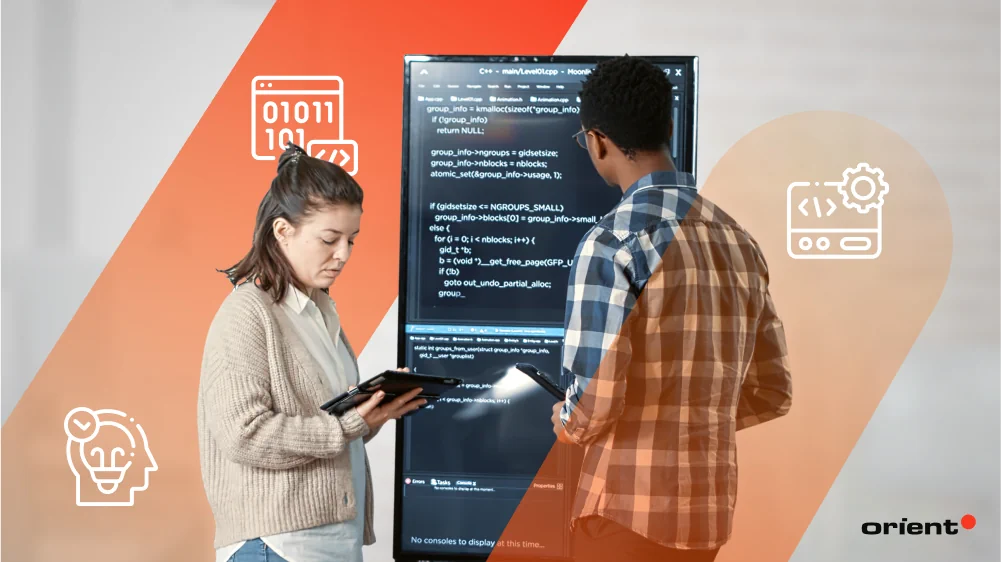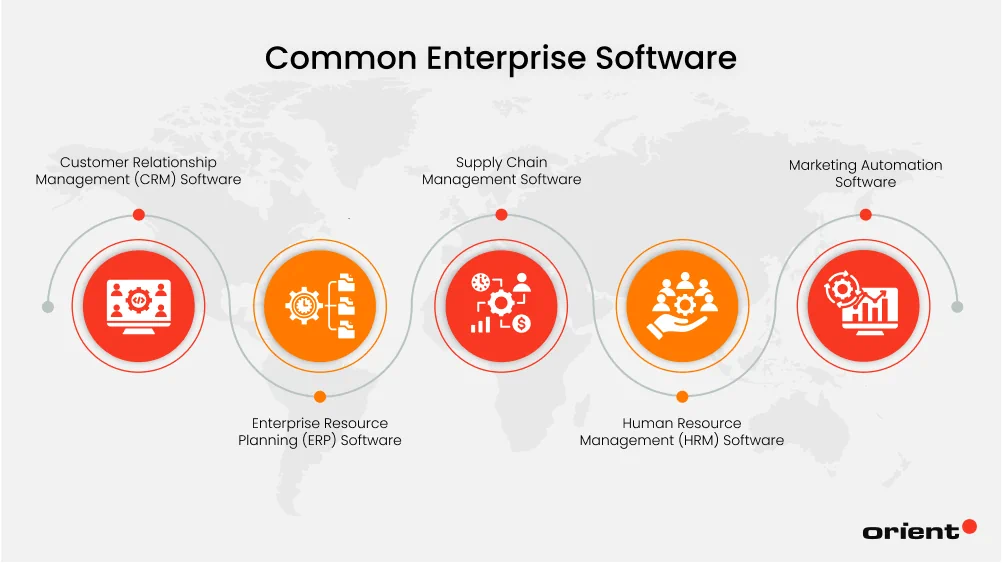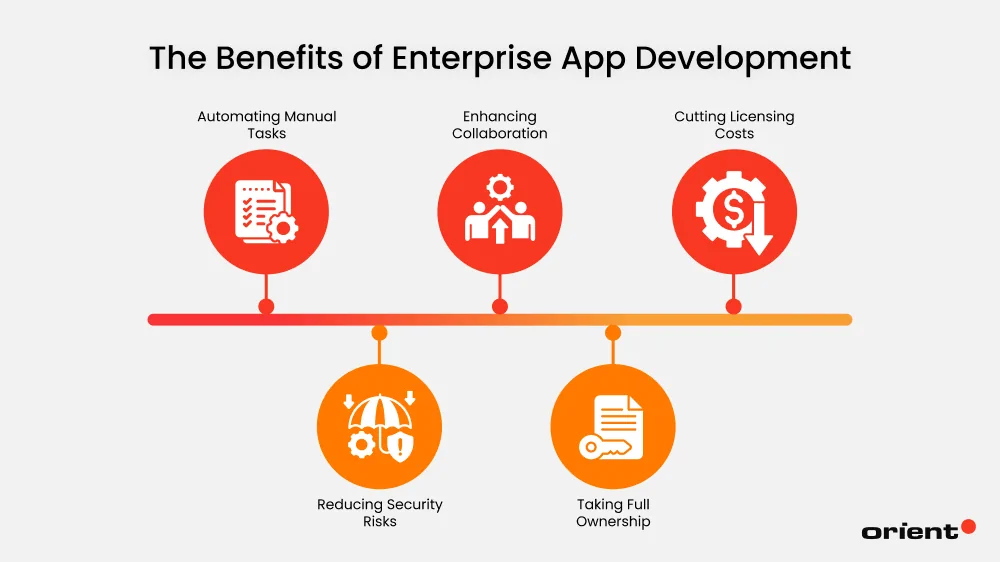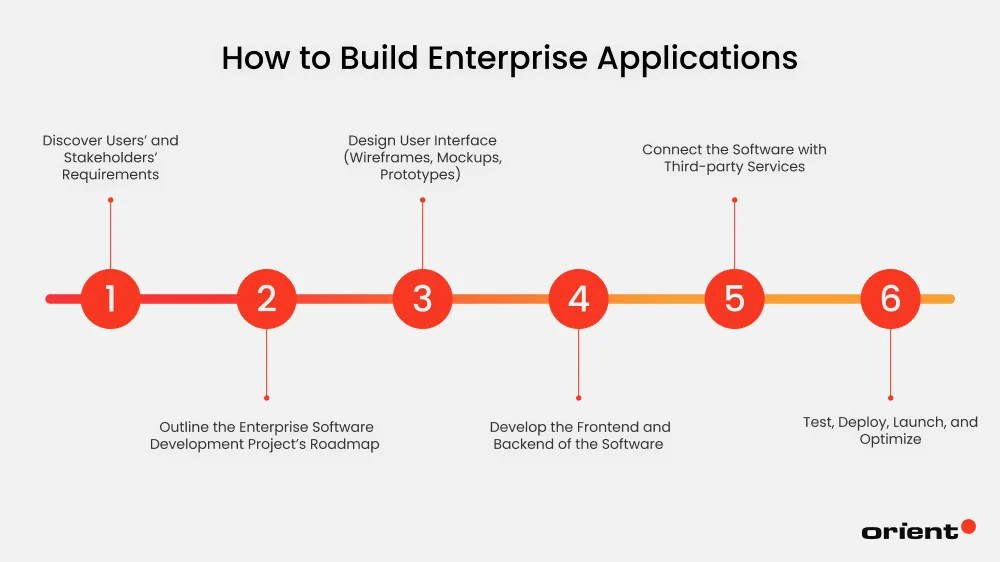Developing your own enterprise systems seems like a good idea to achieve a customized digital experience, increased operational efficiency, and enhanced security. However, have you ever thought of the difficulties you have to go through in such business processes? Longer development timelines due to hiring challenges or knowledge gaps and increased financial burden for long-term support are some, to name a few.
Without the right technical expertise, handling enterprise application development in-house can indeed become an unnecessary drain on time and budget. For these reasons, many businesses have chosen to cooperate with software development partners instead to reduce the hurdle of recruitment and shorten the time to market.
Is outsourcing the right choice for your business? What are the things you need to know about enterprise software development to increase the success rate of the final product? Discover everything right in this article.
What Is Enterprise Software?
Enterprise software is defined as applications that are specially developed to serve the operational and process purposes of a business or organization. Unlike consumer software, which is mostly generic, enterprise applications primarily provide specialized features and tools that are targeted at corporate and facility internal workflows. The end users of this type of software product are the employees of the organization, including the business owner.
Some examples of enterprise systems include customer relationship management (CRM) software, enterprise resource planning (ERP) software, supply chain management software, human resource management (HRM) software, marketing automation software, business intelligence (BI), master data management (MDM) software, etc.
![What Is Enterprise Software?]()
Business apps with the ability to handle large data volumes and various business processes across departments or geographic locations enable medium to large-scale companies to achieve greater efficiency, operational productivity, and collaboration while ensuring a high level of security.
What Is Enterprise Software Development?
So, enterprise software development is the entire process of building custom enterprise software tailored to meet unique business needs and simplify business operations. As enterprise app development provides organizations with the highest level of customization and scalability, such a process goes beyond simple application development and requires the enterprise itself to be directly involved in each development phase, including designing, deploying, and maintaining.
Why Custom Enterprise Software Development Is on the Rise?
According to statistics from Statista, the enterprise software market is expected to reach US$315.00bn by 2025 worldwide. Among the various segments, CRM software dominates the market with an estimated volume of US$98.84bn in 2025. This data clearly reflects the growing real demand of business owners for types of enterprise apps.
The question is, why not already-made software products but enterprise ones?
As each business has its own needs and characteristics in terms of industry, structure, and workflow, the use of off-the-shelf software is considered convenient but only brings general and temporary benefits while lacking the ability to scale up and down with the development of the business. In other words, custom software consistently outperforms already-made solutions in many scenarios, especially in contexts that require tailored functionalities and specific user needs.
![Why Custom Enterprise Software Development Is on the Rise?]()
However, it is insufficient to claim that the growth of enterprise-level software development solely depends on customization. The benefits of enterprise app development also include:
- Automate manual tasks across departments.
- Reduce security risks and protect business data.
- Enhance collaboration between departments through a unified system.
- Own complete control over the software roadmap and ownership.
- Eliminate recurring license fees and third-party tool costs.
Looking more closely at the macro level, we can see that the rise of remote work - a result of digital transformation - has also played an equally important role in the explosive growth in the number of enterprise software products today. Instead of working directly in the office, most technology companies today are gradually shifting to working from home partially or even completely to improve the work-life balance for employees and have easier access to the global talent pool. This is a huge driving force for companies to digitize internal processes, data access, and communications through enterprise applications.
Enterprise Software Development Process: How to Build Enterprise Applications?
![Enterprise Software Development Process: How to Build Enterprise Applications?]()
Whether you outsource your enterprise app development process or not, understanding the fundamentals of its process is never a bad idea as it bridges the gap between business goals and technical implementation, enabling smoother collaboration and better decision-making, not blind trust. The enterprise software development process varies depending on each project’s characteristics. However, this is what a typical process looks like:
Step 1: Discover Users’ and Stakeholders’ Requirements
Why did you come up with the idea of developing your own enterprise software? Was it to enhance collaboration between departments and increase the efficiency of internal operations? If so, the requirements of end users, specifically employees (who will use the system daily) and stakeholders (who fund or influence the project), are the guiding principles for the entire development process. In other words, what they expect from an enterprise app is precisely what you need to achieve. Their input shapes every decision regarding features, workflows, integrations, priorities, and even the technology stack.
Conducting interviews is an ideal way to explore the requirements of the key players above accurately. It is recommended to ask them open-ended questions about their current pain points, goals, workflows, and expectations. To increase the authenticity of the information received, don’t forget to use real-world scenarios to uncover what they actually need, not just what they say they need. The more thorough you are in this step, the more you can avoid costly rework and miscommunication later in the process.
Step 2: Outline the Enterprise Software Development Project’s Roadmap
Kicking off the development process without estimation and planning is like walking down an uncharted road. Doing things on instinct may get you going fast at first, but it is a risky approach that usually results in budget overruns, scope creep, and missed deadlines in the long run. Defining what will be built, how much it will cost, and how long it will take through an actionable development strategy, on the other hand, helps set clear expectations for deliverables and minimize potential roadblocks early. That’s why you need to turn your project vision and user requirements into a realistic timeline in phase 2 of the enterprise software project.
This stage involves technical leads and business analysts and often includes typical activities such as:
- Break down the project into modules or features and estimate how long each piece will take.
- Identify specific roles for the development team.
- Calculate projected costs, including development hours, tools, infrastructure, and support.
- Align timelines with deadlines.
- Set measurable goals (e.g., prototype ready, API tested, MVP deployed).
- Plan mitigation strategies for technical, timeline, and business risks.
Step 3: Design User Interface (Wireframes, Mockups, Prototypes)
Before writing a single line of code, it is crucial to visualize your plan into an intuitive design. Such a process begins with creating the wireframes, which focus on the basic structure of each page (e.g., layout, navigation, and content hierarchy). Then from there, mockups are gradually formed to reflect the actual appearance of the future enterprise software. Finally, interactive simulations of the user interface are tested for validating user experience before development begins with the help of users and stakeholders.
Maintaining a consistent design language for the style guide and related components is recommended. The main guideline here is to ensure user-friendliness rather than offering something that just looks good. So, make sure you take into close consideration all comments and feedback from end users to catch usability issues early and make any necessary changes.
Step 4: Develop the Frontend and Backend of the Software
Let’s move to the core step of the enterprise software development process: developing the front end and back end, where the actual product comes to life.
As frontend is everything the user sees and interacts with like layouts, dashboards, forms, buttons, animations, this activity will take place first to clarify what backend operations are required to support the user actions and backend parallel API development. Developers at this stage typically use the combination of HTML/CSS and frameworks like React, Angular, Blazor, Vue.js to initially take shape of the enterprise software.
Key activities of frontend development include:
- Implementing designs from wireframes, mockups, and prototypes prepared in step 3.
- Building responsive interfaces for mobile, desktop, and tablets.
- Connecting frontend actions to backend services via APIs.
On the other hand, the backend refers to everything happening “under the hood,” which includes data storage, business logic, and server-side processing. Although not as tangible as the front end, backend development plays an important role in powering the entire application and making the app work in accordance with the development direction. The act of validating an order submitted by a user and then sending confirmation to him/her is a real-life example of how the backend actually works behind the scenes. In other words, no matter how beautiful the interface is, if the backend fails, the entire system fails. .NET (C#), Java, Node.js, Python, and Ruby on Rails are several technologies, to name a few that help enterprise software developers complete such a process.
Key activities of backend development include:
- Building APIs to serve data to the front end.
- Managing databases.
- Implementing security protocols (authentication, encryption).
- Processing business rules (approval workflows, financial calculations).
Step 5: Connect the Software with Third-party Services
As rebuilding email delivery or analytics is time-consuming and limiting modern conveniences like cloud syncing often results in poor user experience, many businesses choose to connect their own enterprise app to third-party software rather than build every needed feature from scratch.
There are many popular external tools or systems on the market today, such as PayPal for payment activities, Google Drive for cloud storage, Google Sign-in for authentication, etc. These services can offer free tiers with usage limits or subscription plans with premium features depending on different usage needs. The advice here is to start with free versions first during development and testing to find the right choice before paying for a particular third-party service.
However, in some other cases where data privacy is extremely strict or building fully self-hosted solutions is a strategic choice, you may consider developing internal integration instead of using external services.
Step 6: Test, Deploy, Launch, and Optimize
The final step is to test the enterprise solution carefully before launching it to success. No matter how perfect the coding process is, errors may still appear when deploying to production. Instead of testing the app only once at the end of the development process, you should implement types of testing multiple times in different testing environments to ensure the quality of the final release.
Once everything is kept on track according to the quality criteria, your enterprise software is ready to be deployed and then launched to the end users. Don’t forget to continuously optimize the app and provide further support to optimize the user experience.
When Will You Need Enterprise Software Development Services?
Have you ever asked yourself questions like:
- Why should I use enterprise system development services?
- Should I handle everything in-house?
- When is the right time to outsource enterprise software development projects?
The answer will vary depending on your business needs. If you’re not sure where to start, here are some common signs that indicate when it’s time to seek help from a third party.
When Traditional Software Solutions Cannot Meet Your Needs
The biggest difference between enterprise software development and regular software development lies in the purpose of the solutions being built. While enterprise software development focuses on supporting large-scale internal business processes across departments, consumer-grade software development is for individual users and simpler use cases.
Off-the-shelf software products that fit your general needs in the past are no longer the optimal choice as your business scales up and down time by time.
Applications that contain too many unnecessary features or lack the ones you need but have little to no space to customize cause you a lot of trouble during use. Continuing to use an application that is no longer capable of meeting 100% of your workflows and logic in this situation is one of the factors that hinder the development of the entire company. In addition, vendor lock-in (the state when you are tied to a provider’s support and limitations), ongoing licensing costs, or integration difficulty are also some of the issues related to already-made solutions if you have enough experience to realize them.
All of the above reasons are huge motivations for medium and large business owners to kick-start their own enterprise software projects or even outsource their software development to speed up progress.
When You Lack In-house Technical Expertise
Enterprise applications may sound simple, but they aren’t just basic mobile apps or websites. A typical enterprise app often includes complex software architecture (e.g., microservices), cloud-native development (e.g., AWS, Azure), data compliance (e.g., GDPR, HIPAA), DevOps, and CI/CD pipelines, all of which require a development team with specialized knowledge.
Your developers may be skilled but not experienced in building large-scale, enterprise-grade systems, which is a big thing to deal with. Forcing such complicated processes internally is not recommended as this practice is sure to cost you dearly in the long run, with increased costs from fixing mistakes later being the most serious consequence.
If your internal team does not have the advanced expertise needed for enterprise-level software, it is smarter and safer to bring in professionals who do. Enterprise software engineers coming from outsourcing companies with experience in similar systems from previous projects help you save development time and reduce related risk while ensuring product quality.
When You Want to Focus on Core Competencies
There is no denying the importance of enterprise software in providing a unique user experience. However, it is not a key task that is decisive. Instead, activities directly impacting your business’s success, like product/service innovation, sales, and marketing, do.
Obviously, you can ask your employees to fulfill multiple tasks at the same time, but this approach, unfortunately, is not a good idea at all. Letting your in-house team build a custom backend system while improving your core product inadvertently overloads them, which, over time, causes burnout and affects the speed of implementation and the quality of work.
Bringing in a software partner to handle the complexity so your team can focus on what they do best in this state is one of the best solutions to offload technical heavy lifting while achieving the desired results.
When Time-to-Market Is Critical
Launching fast to respond quickly to market opportunities plays an important role in gaining competitive advantages, especially in time-sensitive situations like meeting stakeholder expectations tied to roadmap delivery. However, fastening your enterprise software development process to meet tight deadlines is not something easy to achieve.
Have you ever launched a project without enough devs, testers, or UX/UI designers or encountered context-switching across multiple internal priorities? Any issues that arise before or during the project have the potential to hold you back.
If time to market is critical to increasing the success of your enterprise software system, using third-party services where expert teams and tools are readily available is an idea worth considering.
When Building In-house Becomes Too Costly
Hiring, training, and retaining an enterprise software developer is an expensive and time-consuming process. It’s not just about salary but also mandatory expenses such as benefits, facilities, work tools, personal development courses, etc. What if your company’s budget constraint does not allow you to meet the above criteria?
As scrapping a hiring plan is impossible because it means a product is unfinished even before it starts, you need help from experts more than anyone else. Enterprise application development services give you quick access to experienced teams with no hiring or training required. With a pay-as-you-go pricing model, you have the flexibility to scale up and down projects without long-term commitments, enhancing financial strategy during the budget-intensive stages of the project.
How to Choose the Right Enterprise Software Development Company
![How to Choose the Right Enterprise Software Development Company]()
Do Market Research
The outsourcing market is a fertile market with countless contributions from custom enterprise software development companies. Just by searching for a keyword like “outsourcing company” or “software development company,” your search bar can return results to hundreds of different websites. The question is, which one is the right choice for you? Market research is the answer in such a situation.
This may take time at the beginning, but it is an ideal way for you to understand the landscape of available vendors and get a clearer view of offerings, specialties, and pricing models from each side. Are they focused on startups or large organizations? Do they promote full-cycle development with dedicated developers or just staff augmentation? The content displayed on their websites will reveal most of the necessary information. Make sure you do not skip the market research step and take it seriously, as this critical phase is the first layer of filtering before deeper evaluation.
Besides searching on Google, you can look up top software development company lists or use platforms like Clutch.co, GoodFirms, G2, and ITFirms to get a better overview of the market.
Ask for Industry-specific References
Once you’ve done your own research, you can solidify your decision by asking for referrals. Note that referrals here should be recommendations from industry peers. As they have been in your shoes, they understand your business context and know all the red flags. Their insider-level insights are considered the most valuable assets to narrow your search and increase the chances of reaching reliable outsourcing partners.
What you see at the top of the search results may be reputable vendors, but whether they’re the best fit for you is anyone’s guess. Some of the best third-party providers don’t advertise heavily. Instead, they grow primarily based on customer base within industries. Industry-specific references can help you reach a specialized team you wouldn’t find through online searches alone.
However, one thing you should take into consideration is that you can and should consider word of mouth, but make sure not to rely on it alone. References are just a trusted filter, not the final decision-maker. Nobody knows your business and your entire enterprise software project better than you, and word-of-mouth recommendations can sometimes be subjective and outdated. Besides industry-specific professional references, don’t forget to look at the issue from many different angles and with your own individual input - that is where the quality decision comes from.
Focus on Long-term Value over Cost
Don’t just go for the lowest is one of the key principles in enterprise software development. However, this is hard to achieve as budget is always the top concern to every business processes. Despite knowing that cheap options are certainly not the best choice, many businesses still tend to rush into low-cost vendors to save costs. This is completely reasonable, but obviously not recommended.
The fact is that short-term savings can lead to long-term losses. What looks cheap upfront can become expensive later due to many factors such as poor quality, missed deadlines, rework, or lack of support. So, how to use the lowest cost but still ensure project efficiency? The answer lies in making smart decisions.
Instead of focusing on price, focus more on the value that a particular software development company can bring to you. Choose a partner that is not only strong in technical skills but also offers transparency in pricing, a clear scope, and reliable delivery; then weigh its cost against its offerings to determine whether you get your money’s worth from them or not.
How Can Orient Software Help Your Enterprise Solution?
![How Can Orient Software Help Your Enterprise Solution?]()
The success of a business app cannot be achieved without the help of a skilled software development team. Developing an enterprise application is undoubtedly a daunting task, but with the right expertise and planning, your project will surely bring good results.
Orient Software is one of the top software development companies located in Vietnam. For the past 20 years of operating in the technology field, we have contributed to realizing many business ideas with high product quality and customer satisfaction. With different engagement models to meet the diverse needs of businesses, Orient Software helps companies of all sizes easily and quickly access a team of experienced developers and accelerate the software development process, thereby creating a competitive advantage for customers across all niches. Contact us to receive free consultation and helpful advice from experts for your upcoming enterprise software project.













